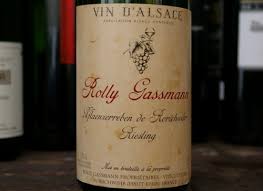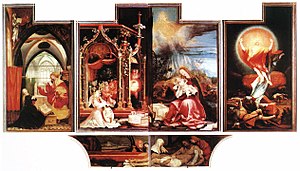Our coach took us to the heights of the Vosges above the village of Lapoutroie at around 900m. The walk took us to La Tête des Faux at 1208m, a focus of some of the fighting between France and Germany in in 1914-1916. Alsace-Lorraine had been ceded to Prussia in 1870, so in 1914 220,000 were called up to the German army. The French advance into Alsace began on 7 August 1914. The Germans occupied La Tête des Faux in August, but it was captured by the French in December and remained in French control for the rest of the war. The Germans had built a concrete fortress of shelters and workshops with electricity, water, phones and a funicular. There is now a French war cemetery.
We came down the mountain by a route unexpected by the coach, so our 9 km walk felt more like 11.5km, before being picked up for lunch in Kaysersberg. On this and previous walks I acquired a lunchtime beer thirst, and the 50cl glass was welcome. This is a village where we have previously stayed for a week, so it was good to renew the acquaintance with a stroll through the village, although the many storks we saw then (August 2010) were now away in some other country.
After lunch we coached to Ammerschwihr to taste the wines of Les Caves JB Adam, though by now we were feeling a little jaded.
The tour concluded for us with dinner in Colmar at 2* Michelin restaurant JYs. We had set ourselves a closing time of 9pm, which meant bidding farewell after the pre-dessert amuse bouches. Hardy souls in the remainder of the party were to move on to a tasting of sweet wines and eaux-de-vie at the hotel.
Our train left Colmar at 5.54 am for Basel, and two more connections brought us to Geneva Airport for the trip home.
Tuesday, 20 September 2016
Monday, 19 September 2016
Tour Day 4 Walk Bergheim to Ribeauvillé, Wine tasting
The day's walk was supposed to be an easy 5.3 km stroll through the vineyards, but with temperature in the early 30s and no shade, it still presented some challenges.
 After lunch of potato fritters and salmon, & apple tart with salty caramel ice cream, we had two wine tastings: the first was at Maison Trimbach, also at Ribeauvillé, a polished exporter of fine whites (can't find any in Australia on the web). We then coached on to a truly extraordinary experience of a family wine house in Rorschwihr, Rolly Gassman.
After lunch of potato fritters and salmon, & apple tart with salty caramel ice cream, we had two wine tastings: the first was at Maison Trimbach, also at Ribeauvillé, a polished exporter of fine whites (can't find any in Australia on the web). We then coached on to a truly extraordinary experience of a family wine house in Rorschwihr, Rolly Gassman.

Grandmère Marie Thérèse Rolly personally showed us a seemingly endless variety from her endless cellar. Many bottles she opened were aged and expensive. Her pride in the Domaine's products and her generosity were a highlight of the tour.
Tour day 4 Monday September 12
A leisurely Monday morning in Colmar was given to a guided visit to Collégial St Martin (named for Martin of Tours) and Église des Domincans.
Unlike a church previously visited, the Collégial had fine tympana. Maybe Colmar was not so revolutionary or the human figures were not perceived as religious! The central figure is St Nicolas - those on his right are receiving alms.
Stained glass spanned several periods, but we were told that this face of Christ dated from early in the current church's history- some time around the 1200s. Note -large blue eyes and golden hair!
Outside, the roof has coloured tiles and large gargoyles-
Unlike a church previously visited, the Collégial had fine tympana. Maybe Colmar was not so revolutionary or the human figures were not perceived as religious! The central figure is St Nicolas - those on his right are receiving alms.
Stained glass spanned several periods, but we were told that this face of Christ dated from early in the current church's history- some time around the 1200s. Note -large blue eyes and golden hair!
Outside, the roof has coloured tiles and large gargoyles-
One is a pig, "judensäue" a testament to a troubled history of Jews in medieval Alsace as there is also a similar corner sculpture on a portal.
Resumption of narrative- Tour day 3 Sunday afernoon September 11
(This entry has been delayed by the pace of the tour.)
After our walk described in the previous post, we had a traditional lunch in Munster- an onion tart with choucroute.

We then took the coach back to Colmar for a visit to Musée d'Unterlinden where a local guide gave us a detailed explanation of the Isenheim Altarpiece sculpted and painted by, respectively, the Germans Niclaus of Hagenau and Matthis Grümewald in 1512-1516.
We felt that this gave us a much better understanding of the faith of the time and place of this expression than could be discerned by mere personal contemplation of the work. Since Wikipedia has excellent illustrations of the layers, they are copied here.
en.wikipedia.org/wiki/Isenheim_Altarpiece


https://en.wikipedia.org/wiki/Isenheim_Altarpiece
Monday, 12 September 2016
A walk in the woods
The coach on Sunday took us to Munster, where a festival of mountain horns was in preparation, but not destined for our ears



 J
J


We walked a 9.5 km circle into the Vosges foothills, "moderately strenuous", rising from 344m to 582m. A break for as much Munster and Beaufort cheese as we wished, and several valley views were the highlights.


On our descent we saw a chap working on house maintenance and gave him a cheery bonjour, which he returned, but then heard English voices and revealed himself as Australian that this was the gite where he spends 8 months of the year, and September- January in Aust.
 J
J M.R. Wine, Walks, & Art in Alsace
Our tour, organised by Martin Randall Travel, started for us by a walk to Domaine Viticole de la Ville de Colmar, where just before 4.30pm we joined up with the 9 others, the manager and the cultural guide who had travelled from St Pancras by Euorostar that morning. The vineyard and winery really is owned by the Ville. 






Our hostess gave an extended talk on the vineyard (to be harvested by hand starting Monday), the effects of climate change on wine making, and their approach to the task. We then had a tasting of the main 3 white and 1 red varieties they produce. We noticed that they also make sparkling, called crémant for regulatory reasons. Although only a small maker they comply with regulations to produce "grand cru" label wines.
On adjournment to our hotel for dinner the main course was Baeckaoffe, which we were told is an Alsacien casserole of mutton, pork, beef and potatoes.
On Saturday our coach took us to one of the many postcard pretty villages, Rosheim, about 60k up the road.

A local guide gave us a thorough introduction to the Romanesque church of Saintes Pierre et Paul. It had been somewhat iconoclasted (my newly minted word of the day) during the French Revolution. Anything religious looking got smashed but other icons survived. In my photo of the apse the Angel symbol has been destroyed, but the other 3 evangelist icons remain. Similarly the tympani have been chiselled off, and the great west entrance is no longer used.

We then went for a 5k walk through the vineyards to Obernai. This commenced with a vigorous 13% ascent into the Vosges foothills that quickly sorted the sheep from the mountain goats.
Obernai boasts full employment from agricultural, industrial and tourist trade. Another post card picture town.

There is another church of Saintes Peter and Paul, and during our visit there was a hot market in weddings: four were performed by law in the hôtel de Ville by Madame la Maire, and at least one party then proceeded to the Saintes for a nuptial mass. One bride arrived by horse and buggy, another was in a snappy red sports coupé. We listened to a fine moderate sized organ and tenor practising: there was another much larger organ at the west end of the church.
On to another wine tasting, Vins Robert Blanck, a traditional producer using barrels only. Since tannin is not necessary for Alsacien whites, the white
barrels can be kept indefinitely. Some are very old indeed, with carved fronts:


The day ended with a 3 course dinner at a fish restaurant (fresh water fish).
Saturday, 10 September 2016
Transit to Colmar
On Thursday we took the train to Colmar, where we plan to join an English tour group. Our group hotel is a historic building, Maison des Têtes.








The building dates from 1609 and is named for the number of faces on, of course, its façade. On top is an Alsace barrel maker marking when it was Colmar's Bourse de vins.

We had an exploratory walk around town in the morning, and found a please park, the Champ de Mars.


This fountain dedicated to an admiral, has statues representing four continents, also named for specific people, one a grandmother of Yves St Laurent, another the negro in the foreground Albert Schweizer (an Alsacien).
At the end of the path another name

How would such an ascription be received in an Australian context? We have revived glory for World War fallen, but I haven't anyone say of a soldier in a modern battle context "died for Australia", yet that is consistent with the duty of a military volunteer. France is quite frank about such matters, as shown by this plain speech in the centre of town

And for something brighter, here is cute Colmar, the Koifhus, a bonded warehouse downstairs and Council chamber for a 10 city alliance upstairs, the building dating from 1480.

Subscribe to:
Comments (Atom)














